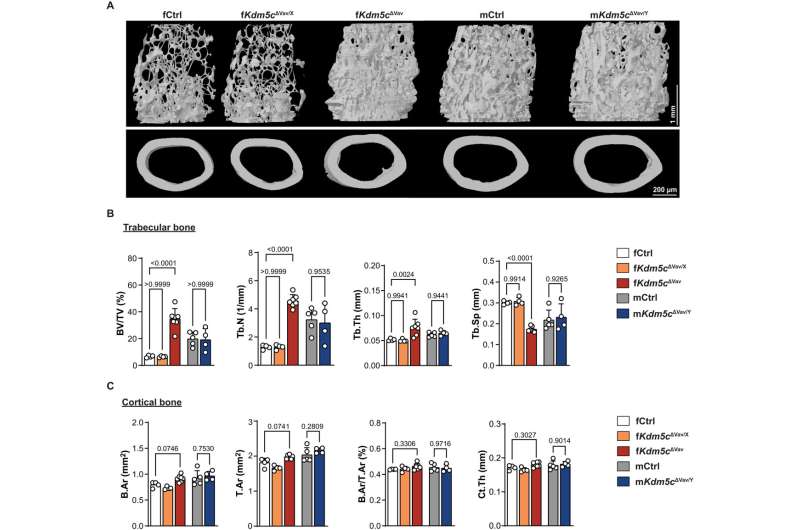This article has been reviewed according to Science X'seditorial processandpolicies.Editorshave highlighted the following attributes while ensuring the content's credibility:
fact-checked
peer-reviewed publication
trusted source
proofread
Osteoporosis treatments may benefit from discovery of key driver of low bone density

Van Andel Institute scientists have pinpointed a key driver of low bone density, a discovery that may lead to improved treatments with fewer side effects for women with osteoporosis.
The findings are described in a study published this month inScience Advancesby VAI Associate Professors Connie M. Krawczyk, Ph.D., and Tao Yang, Ph.D.
Their research reveals that loss of an epigenetic modulator, KDM5C, preservesbonemass in mice. KDM5C works by altering epigenetic "marks," which are akin to "on" and "off" switches that ensure the instructions written in DNA are used at the right time and in the right place.
"Osteoporosis is a common disease that can have debilitating outcomes," Yang said. "KDM5C is a promising target to treat low bone mass in women because it is highly specific. We're hopeful that our findings will contribute to improved therapies."
Nearly 19% of U.S. women aged 50 and older have osteoporosis in their hips and lower spines. Osteoporosis-associated weakening of the bones increases the risk of fractures and poses significant risks to health and quality of life.
Several medications are approved to treat osteoporosis but fears of rare,severe side effectsoften are a barrier for their use. Treatments that leverage the hormone estrogen also are available, but are only recommended for low-dose, short-term use due in part to associations with cancer risk.
It is well-established that women experience disproportionately lower bone mass than men throughout their lives. Loss of bone mass accelerates with menopause, increasing the risk of osteoporosis and associated fractures for women as they age.
To figure out why this happens, Krawczyk, Yang and their teams looked at the differences in the ways bone is regulated in male and female mice, which share many similarities with humans and are important models for studying health and disease. They focused on specialized cells called osteoclasts, which help maintain bone health by breaking down and recycling old bone.
The researchers found reducing KDM5C disrupted cellular energy production in osteoclasts, which slowed down the recycling process and preserved bone mass. Importantly, KDM5C is linked to X chromosomes, which means it is more active in females than in males.
“降低KDM5C水平就像扔一个开关to stop an overactive recycling process. The result is more bone mass, which ultimately means stronger bones," Krawczyk said. "We're very excited about this work and look forward to carrying out future studies to refine our findings. At the end of the day, we hope these insights make a difference for people with osteoporosis."
更多的信息:Huadie Liu et al, The histone demethylase KDM5C controls female bone mass by promoting energy metabolism in osteoclasts,Science Advances(2023).DOI: 10.1126/sciadv.adg0731



















